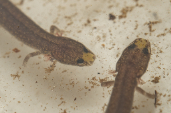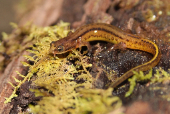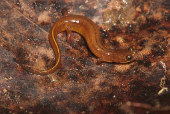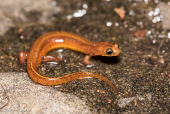Patch-Nosed Salamander (Urspelerpes brucei)
Description: This genus is believed to be closely related to brook salamanders (genus Eurycea), but have five toes on their feet. A distinctive characteristic is a yellowish patch on the snout. Urspelerpes is tiny, and adults are about 2 inches long. Males and females have different coloration, with males having a pair of dark stripes running down their bodies, with yellow backs, and females being more muted in color (a more common trait in birds). Similar to other salamander species.
Habitat: This species can be found in small streams associated with steep-walled ravines, either within the stream or along the banks. Individuals have been found under rocks and in loose leaf litter; however, it is thought that they might occupy more terrestrial microhabitats under suitably moist conditions.
Range: This species is currently known from more than twenty-four small streams in the Appalachian foothills (Blue Ridge escarpment in Stephens County and Habersham County) of northern Georgia, and three sites across the Tugaloo River in Oconee County, South Carolina. All sites can be found within an area of less than 31 km2, and range in elevation from 200 to 400 m asl. Preliminary genetic data show population structure across regions, with the Tugaloo River likely acting as a barrier to gene flow between Georgia and South Carolina
Found in these States:
GA |
SC
Diet: this genus is believed to eat small terrestrial prey using its projectile tongue.
Reproduction: Not Available
Status: Listed as Near Threatened because the continued survival of this species is entirely dependent on the protection and rigorous management of its habitat provided by the protected areas in which it occurs. Without this level of protection, it is very likely that the speciesí habitat would be degraded and fragmented resulting in significant population declines, which would warrant an immediate uplisting.
»» Kingdom: Animalia - Animals
»» Phylum: Chordata - Chordates
»» Subphylum: Vertebrata - Vertebrates
»» Class: Amphibia - (Amphibians)
»» Order: Caudata - Salamanders
»» Family: Plethodontidae - Lungless Salamanders
»» Genus: Urspelerpes
»» Species: Urspelerpes brucei - Patch-Nosed Salamander
This article uses material from the Wikipedia article "Urspelerpes", which is released under the Creative Commons Attribution-Share-Alike License 3.0. Content may have been omitted from the original, but no content has been changed or extended.
|













